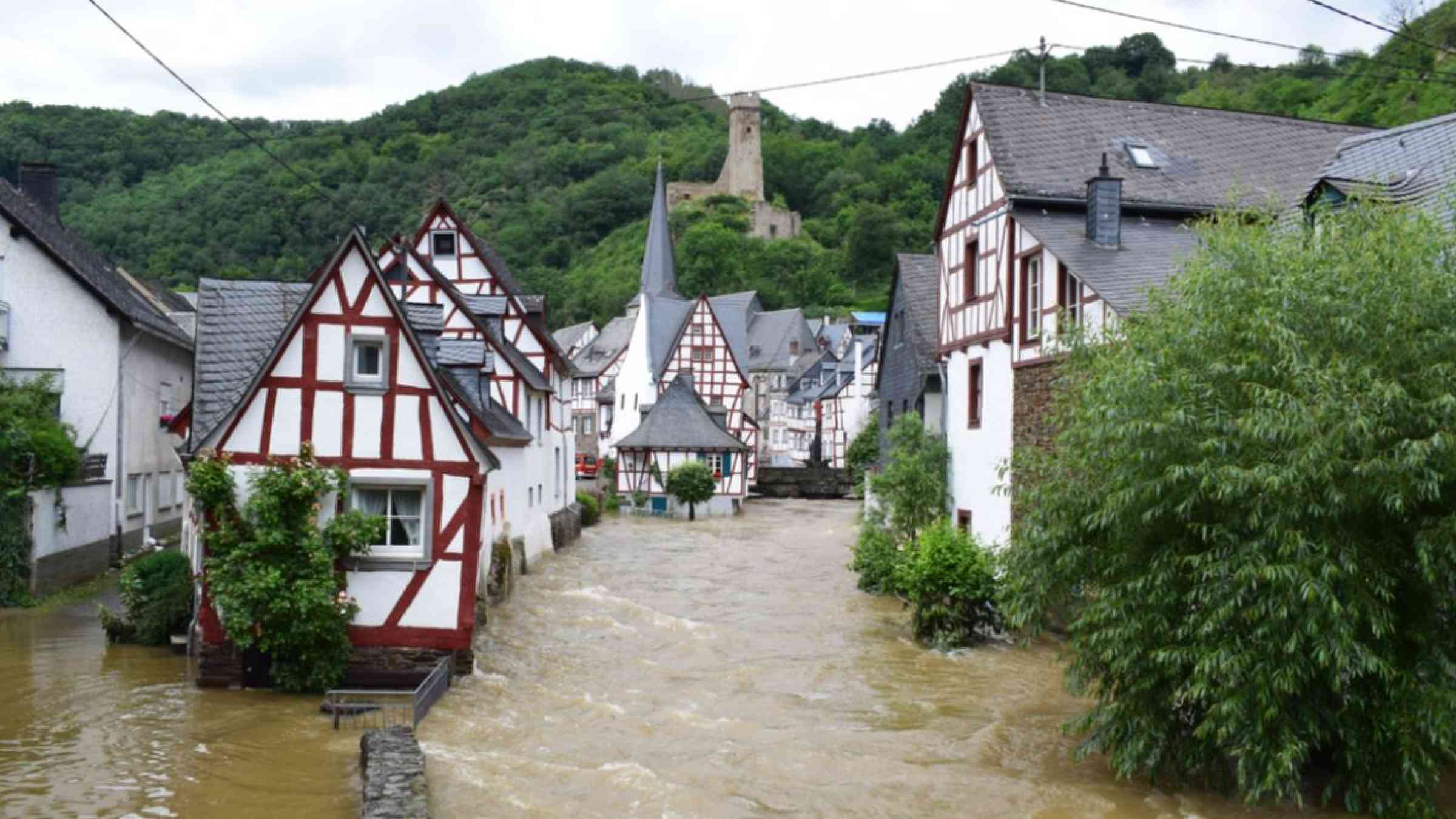Heavy rainfall which led to severe flooding in Western Europe made more likely by climate change

From the 12th to the 15th of July, heavy rainfall associated with cut-off low-pressure system “Bernd” led to severe flooding particularly in the German states North Rhine-Westphalia and Rhineland-Palatinate, as well as in Luxembourg, and along the river Meuse and some of its tributaries in Belgium and the Netherlands.
At the time of the heavy rainfall event, soils were in part already saturated. Some valley sections are very narrow with steep slopes leading to funnel-like effects in the event of extreme floods. These factors were modified locally also by differences in land cover, infrastructure and water management alleviating or increasing the devastation of the extreme flooding. At the Ahr river the flood is estimated to be a 500 year event or rarer according to preliminary data.
The flooding resulted in at least 184 fatalities in Germany and 38 in Belgium and considerable damage to infrastructure, including houses, motorways and railway lines and bridges and key income sources. Road closures left some places inaccessible for days, cutting off some villages from evacuation routes and emergency response. The worst affected areas were around the rivers Ahr, Erft and Meuse.
Scientists from Germany, Belgium, the Netherlands, Switzerland, France, Luxembourg, the US and the UK, collaborated to assess to what extent human-induced climate change altered the likelihood and intensity of the heavy rainfall causing the severe flooding.
Using published peer-reviewed methods, we analysed how human-induced climate change affected maximum 1-day and 2-day rainfall events in the summer season (April-September) in two small regions where the recent flooding has been most severe in the Ahr-Erft region (Germany) and on the Meuse (Belgium) and anywhere over a larger region including Germany, Belgium and the Netherlands.
Main findings
- The severe flooding was caused by very heavy rainfall over a period of 1-2 days, wet conditions already before the event and local hydrological factors. While river discharge and water levels are the physical components most directly linked to the impacts of the event, we focus our assessment on the main meteorological driver, the heavy rainfall event. This is due to the fact that some hydrological monitoring systems were destroyed during the flood and data of sufficiently high quality and quantity is not currently available.
- The observed rainfall amounts in the Ahr/Erft and the Belgian part of the Meuse catchment broke historically observed rainfall records by large margins. In regions of that size the robust estimation of return values and the detection and attribution of trends is challenging and thus pushes the limits of what current methods of extreme event attribution are designed for.
- Therefore we broadened the analysis by assessing the influence of climate change on similar types of events that could occur anywhere in Western Europe in a large region between the north of the Alps and the Netherlands. We found that in the current climate, for a given location within this larger region, we can on average expect one such event every 400 years. That also means we expect such events to occur more frequently than once in 400 years within the larger Western European region.
- Climate change increased the intensity of the maximum 1-day rainfall event in the summer season in this large region by about 3 – 19% compared to a global climate 1.2 °C cooler than today. The increase is similar for the 2-day event.
- The likelihood of such an event to occur today compared to a 1.2 °C cooler climate has increased by a factor between 1.2 and 9 for the 1-day event in the large region. The increase is again similar for the 2-day event.
- These numbers are based on an assessment including observations, regional climate models and very high resolution climate models that directly simulate convection. The changes in intensity and likelihood are larger in the observation-based assessment compared to all models.
- In a climate 2 °C warmer than in preindustrial times models suggest that the intensity of a 1-day event would increase by a further 0.8-6% and the likelihood by a factor of 1.2-1.4. The increase is again similar for the 2-day event.
- The July 2021 floods resulted in extreme impacts including over two hundred deaths. Given the rarity of the event it is clear this is a very extreme event that is reasonably likely to cause negative impacts. However, especially given events like this will occur more frequently in the future, examining how vulnerability and exposure can be reduced becomes critical to reducing future impacts.
In summary, our results highlight that at local scale detection of extreme precipitation trends is hindered by variability, but when considering such events occurring over the larger Western Europe region, significant trends attributable to human-induced climate change are evident even if we cannot predict where exactly these events occur. All available evidence taken together, including physical understanding, observations over a larger region and different regional climate models give high confidence that human-induced climate change has increased the likelihood and intensity of such an event to occur and these changes will continue in a rapidly warming climate.